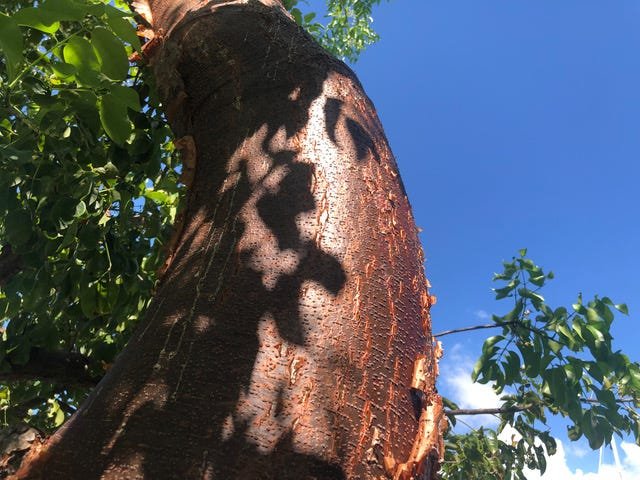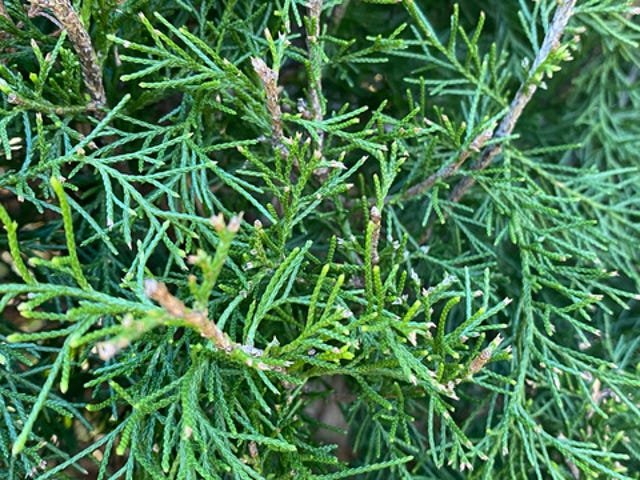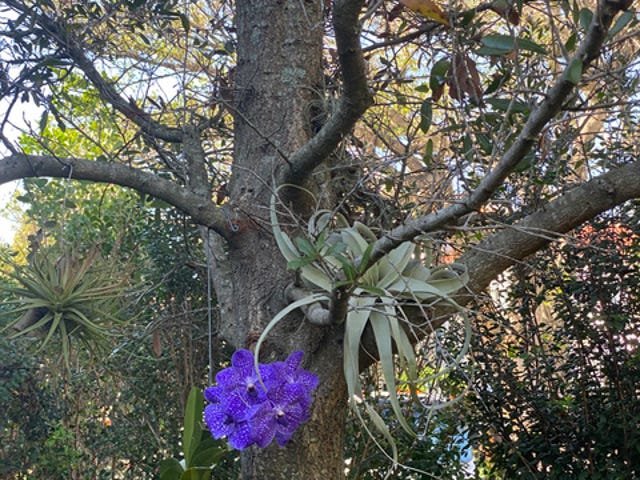We need to realign with nature, and it starts in our backyards
The gumbo limbo tree is recognizable by its coppery bark. The tree is salt-,drought-, and wind-tolerant
February 13, 2021
Doug Tallamy, a professor of entomology at the University of Delaware, gave another terrific talk last week at the Preservation Foundation, and his message was one we could all benefit from hearing.
In his first book, Bringing Nature Home (2007), Tallamy wrote about the importance of native plants in providing the nourishment essential to sustaining environments suitable for the insects, birds and wildlife we need in our world.
In his most recent book, Nature’s Best Hope (2020), he provides the blueprint for an approach to conservation that every one of us can easily follow to ensure the support of the ecosystems upon which we all depend.
Fragrant, needle-like foliage of a red cedar
A World Wildlife Foundation global study published in September noted that 66% of the world's wildlife has declined or vanished since 1970, Tallamy said. That’s two-thirds of all wildlife. A cultural transformation is needed for us to reassess our dependence on, rather than our dominance of, the natural world.
If we all add thoughtful native plantings to our individual landscapes, we can create corridors of sustainable ecosystems through which wildlife can flourish. It’s not enough to have parks and open space here and there; the ecosystems must be connected.
Tallamy provides some basic tenets to accomplish this, the first being to shrink the size of our lawns, which currently total more than 40 million acres nationwide. Lawns that require toxic fungicides, fertilizers and irrigation are all huge contributors to expensive environmental wastelands. Secondly, we need to plant native species that will support the insects and thus the wildlife they have evolved with over the last millennia.
The countless alien species we have imported from Europe, Asia and elsewhere, while often beautiful, cannot support our native insect populations. You don’t need to run out and remove all your exotic trees and plants, but simply adding some natives into the mix will provide sustenance for the essential pollinators that cannot live without them (and without whom we cannot survive, either).
We have grown up with the notion that humans and nature cannot co-exist, but that stems from the days of hunter-gatherers when our survival depended on killing the creatures that would otherwise kill us. That is hardly the case today, but we continue to live by those same rules. Now we must collectively realize that our survival as a species depends upon our coexisting with nature – and this has to start in each of our backyards.
The red cedar grows in Pan’s Garden at the Preservation Foundation This versatile tree is drought-tolerant and its lovely cronical shape makes it beautiful as a specimen.
Pollinators and birds
Let’s zero in on sustenance for pollinators and birds. Keystone plants, those that support native food webs, provide 75% of the caterpillar food that birds need to survive.
Bees pollinate 90% of our flowering plants and 40-50% of our food crops. Caterpillars transfer more energy from plants to animals than any other plant eaters in the insect world. Most birds rear their chicks exclusively on caterpillars, which are nutritious and soft, so they are easily stuffed down the throats of their young. They are also the best source of carotenoids, substances made only by plants that are as essential to birds as they are to human health.
A canopy of mature live oaks. Oak tree are among the most beautiful trees around, and easily incorporated into your landscape
Popular trees
Oaks are one of the single most important keystone plants, supporting 600 species of caterpillars in the mid- Atlantic region and up to 900 species nationwide. Here in Florida, live oaks (Quercus virginiana) are among the most beautiful trees around, and easily incorporated into your landscape.
I have just finished a garden only 40 feet by 85 feet, and I have two live oaks, a gumbo limbo, three thatch palms, and a border of sabal palms and Simpson's stoppers. In less than a month I have seen several species of birds and numerous pollinators, including bees, dragonflies and sphinx moths.
Live oaks are evergreen and provide dependable and critical shade canopies that are a very desirable feature for South Florida landscapes. They also offer essential cover for songbirds and other wildlife during winter months, These trees are relatively slow-growing, with an ultimate height of 50-60 feet, but they are long-lived, and environmentally essential. If you have room on your property, plant this tree, fit some orchids into the branches, add some Spanish moss, and you’ll have an instant show- stopper!
The red berries of the lignum vitae are beautiful against a blue skye
Laurel oak (Quercus laurifolia) is another beautiful oak for South Florida landscapes. Preferring sandy, moist, well-drained soils, this is best suited to banks of lakes and rivers. With semi-evergreen foliage and deeply furrowed bark, this has a lovely pyramidal shape when young, becoming more rounded with age. As with all oaks, the acorns provide essential food for wildlife and the leaves harbor insects for birds.
Another wonderful tree that makes a valuable specimen is the persimmon (Diospyros virginiana). This tough native adapts to many adverse conditions, including hurricane-force winds, and performs well in sandy soil in most environments, in sun or light shade. The glossy oval deep green leaves turn a lovely yellow in autumn, then deepen to a glorious reddish purple. Fragrant, greenish white flowers become round orange fruits in the fall, delicious when fully ripe although always slightly astringent.
Persimmon is the larval host for a number of moths, including the lunar, the royal walnut, Wittfeld’s forester and the pin-striped slug moth. This tree is dioecious, meaning male and female flowers are on separate trees, so if you want fruit, plant a female and make sure there is a male relatively close by. This is usually a small tree, growing to about 20 feet, but it can get much taller. Why not plant this wonderful native and add a little piece of local Florida color to your garden?
Another terrific native is the red cedar (Juniperus virginiana). This versatile tree is drought-tolerant and its lovely conical shape makes it beautiful as a specimen. It also works well as a screen, windbreak, or in a mass planting. The fragrant dense, bluish-green foliage provides good cover for birds; the berries are an important food source for birds and other wildlife.
Gumbo limbo (Bursera simaruba) and lignum vitae (Guaiacum sanctum) are perhaps my favorite specialty trees. The fast-growing, salt-, drought-, and wind-tolerant gumbo limbo has spectacular coppery bronze bark that stands out against any background. Its dark red berries attract numerous birds, including flycatchers, orioles and vireos. It is not particular as to soil conditions, and is recommended as a rugged, hurricane-resistant species, making it is especially valuable in South Florida.
The flowers of a lignum vitae, with are produced in April and sporadically throughout the year
Lignum vitae should be considered among the very best of our native trees. With a compact canopy of deep green foliage, this produces beautiful clear blue star-shaped flowers in April and sporadically throughout the year. Flowers are followed by yellow fruits that split open to reveal bright red inner seeds that birds love.
Skipper butterflies frequent the flowers and the leaves provide the larval food for the rare lyside sulphur butterfly. Although readily propagated by seed, this is a very slow-growing tree. Its extremely dense wood was so valuable that its overcollection in the wild has led to its current endangered status. This outstanding small tree deserves a place of honor in any garden.
The branches of live oaks are great for hanging tillandsia and orchids
Do our part
With the incredible variety of native trees, shrubs, flowers, ground covers, and vines available, there is no reason we all can’t add at least a few to our landscapes. And that is Tallamy’s basic message – we all need to do our part. As he eloquently states:
“Every person on earth depends entirely on the quality of the earth’s ecosystems. So, every person on earth, not just a few scientists (or ecologists) bears a responsibility for good earth stewardship. This approach empowers us all and shrinks the (global) problem to something manageable for each one of us."
-Kim Frisbie
Original article on the Palm Beach Daily News is HERE.







